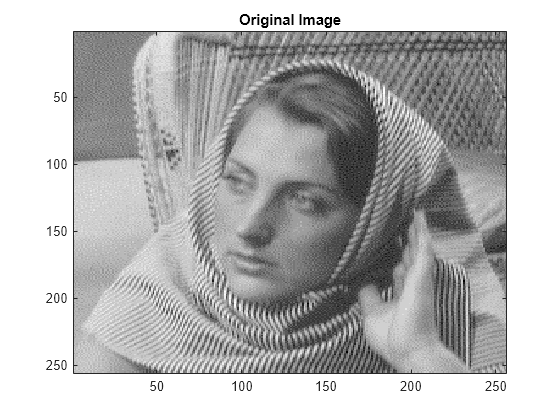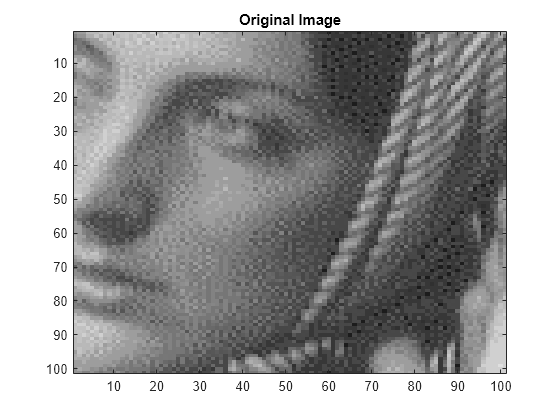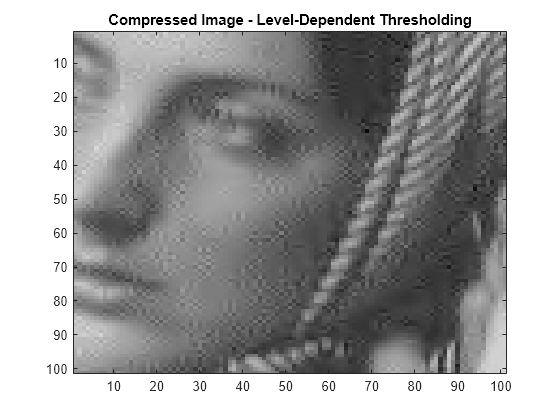Data Compression using 2-D Wavelet Analysis
The purpose of this example is to show how to compress an image using two-dimensional wavelet analysis. Compression is one of the most important applications of wavelets. Like denoising, the compression procedure contains three steps:
Decompose: Choose a wavelet, choose a level N. Compute the wavelet decomposition of the signal at level N.
Threshold detail coefficients: For each level from 1 to N, a threshold is selected and hard thresholding is applied to the detail coefficients.
Reconstruct: Compute wavelet reconstruction using the original approximation coefficients of level N and the modified detail coefficients of levels from 1 to N.
The difference with the denoising procedure is found in step 2. There are two compression approaches available:
The first consists of taking the wavelet expansion of the signal and keeping the largest absolute value coefficients. In this case, you can set a global threshold, a compression performance, or a relative square norm recovery performance. Thus, only a single parameter needs to be selected.
The second approach consists of applying visually determined level-dependent thresholds.
Load an Image
Let us examine a real-life example of compression for a given and unoptimized wavelet choice, to produce a nearly complete square norm recovery for an image.
load woman; % Load original image image(X) title('Original Image') colormap(map)

x = X(100:200,100:200); % Select ROIMethod 1: Global Thresholding
The compression features of a given wavelet basis are primarily linked to the relative scarceness of the wavelet domain representation for the signal. The notion behind compression is based on the concept that the regular signal component can be accurately approximated using the following elements: a small number of approximation coefficients (at a suitably chosen level) and some of the detail coefficients.
n = 5; % Decomposition level w = 'sym8'; % Near symmetric wavelet [c,l] = wavedec2(x,n,w); % Multilevel 2-D wavelet decomposition
In this first method, the WDENCMP function performs a compression process from the wavelet decomposition structure [c,l] of the image.
opt = 'gbl'; % Global threshold thr = 20; % Threshold sorh = 'h'; % Hard thresholding keepapp = 1; % Approximation coefficients cannot be thresholded [xd,cxd,lxd,perf0,perfl2] = wdencmp(opt,c,l,w,n,thr,sorh,keepapp); image(x) title('Original Image') colormap(map)

figure
image(xd)
title('Compressed Image - Global Threshold = 20')
colormap(map)
Compression score (%)
perf0
perf0 = 74.3067
L2-norm recovery (%)
perfl2
perfl2 = 99.9772
The density of the current decomposition sparse matrix is:
cxd = sparse(cxd); cxd_density = nnz(cxd)/numel(cxd)
cxd_density = 0.2569
Method 2: Level-Dependent Thresholding
The WDENCMP function also allows level and orientation-dependent thresholds. In this case the approximation is kept. The level-dependent thresholds in the three orientations horizontal, diagonal, and vertical are as follows:
opt = 'lvd'; % Level-dependent thresholds thr_h = [17 18]; % Horizontal thresholds thr_d = [19 20]; % Diagonal thresholds thr_v = [21 22]; % Vertical thresholds thr = [thr_h ; thr_d ; thr_v];
In this second example, notice that the WDENCMP function performs a compression process from the image x.
[xd2,cxd2,lxd2,perf02,perfl22] = wdencmp(opt,x,w,2,thr,sorh);
image(x)
title('Original Image')
colormap(map)
figure
image(xd2)
title('Compressed Image - Level-Dependent Thresholding')
colormap(map)
Compression score (%)
perf02
perf02 = 77.3435
L2-norm recovery (%)
perfl22
perfl22 = 99.6132
The density of the current decomposition sparse matrix is:
cxd2 = sparse(cxd2); cxd2_density = nnz(cxd2)/numel(cxd2)
cxd2_density = 0.2266
Summary
By using level-dependent thresholding, the density of the wavelet decomposition was reduced by 3% while improving the L2-norm recovery by 3%. If the wavelet representation is too dense, similar strategies can be used in the wavelet packet framework to obtain a sparser representation. You can then determine the best decomposition with respect to a suitably selected entropy-like criterion, which corresponds to the selected purpose (denoising or compression).